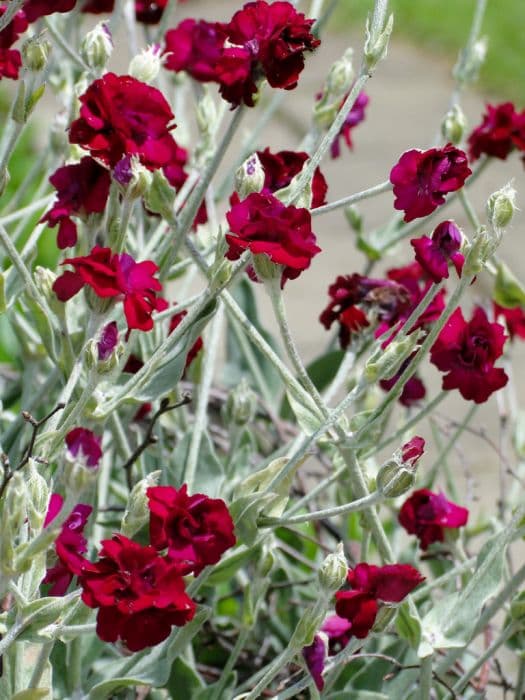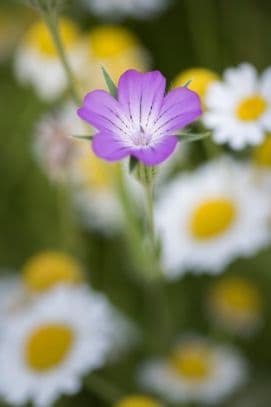Rock Soapwort Saponaria ocymoides 'Rubra Compacta'
ABOUT
Saponaria ocymoides 'Rubra Compacta', commonly known as rock soapwort, is an attractive perennial plant often prized for its showy flowers and ground-covering abilities. This cultivar provides a dense mound of glossy, slightly oval-shaped leaves which emanate a bright, lush green coloring. The foliage presents a vibrant backdrop that persists throughout the growing season. The true charm of rock soapwort lies in its blossoms. The flowers of 'Rubra Compacta' are a striking shade of deep pink to ruby red, and they emerge in profusion. Each flower is small and rounded, boasting five slightly notched petals which radiate around a central eye. These blooms typically display a clustered arrangement, coming together in loose, cushion-like groupings that blanket the plant's foliage in a profuse show of color. Flowering is most intense during late spring to early summer, at which time the plant becomes a vibrant spectacle of color. The overall visual effect of rock soapwort is one of a colorful, frothy cascade, often spilling delightfully over rockeries or walls and providing a pleasing contrast against harder surfaces or more muted greenery. The texture of rock soapwort's foliage and flowers contributes to its decorative appeal. The leaves are plump and almost succulent in appearance, offering a visual impression of lushness and vitality. The juxtaposition of soft, fluffy flowers against these leaves creates an inviting tactile element within garden compositions. Aside from its visual attributes, rock soapwort is also known for its ease of care and its adaptability to a variety of garden conditions, which makes it a popular choice for gardeners seeking both beauty and resilience in their plant selections.
About this plant
 Names
NamesFamily
Caryophyllaceae.
Synonyms
Rock Soapwort, Tumbling Ted, Rock-Soapwort 'Rubra Compacta'.
Common names
Saponaria ocymoides 'Rubra Compacta'.
 Toxicity
ToxicityTo humans
Rock Soapwort contains saponins, which are toxic substances that can cause poisoning if ingested in large amounts. Saponins are not highly toxic to humans, and the risk of poisoning is generally low. However, if someone eats significant quantities of Rock Soapwort, they could experience symptoms such as nausea, vomiting, and diarrhea. In severe cases, ingestion could lead to hemolysis, which is the destruction of red blood cells, although such severe toxicity is rare in humans due to the low concentration of saponins in the plant and the typically small amounts that might be ingested accidentally.
To pets
Rock Soapwort is also toxic to pets due to the presence of saponins. Similar to humans, pets that consume parts of Rock Soapwort may experience mild to moderate gastrointestinal distress, which can include symptoms like vomiting and diarrhea. In larger amounts, the saponins can lead to more serious symptoms such as weakness, lethargy, and in very severe cases, hemolysis leading to anemia. Pet owners should keep pets away from the plant to prevent accidental ingestion and should seek veterinary attention if they suspect their pet has eaten a substantial amount of the plant.
 Characteristics
CharacteristicsLife cycle
Perennials
Foliage type
Semi-deciduous
Color of leaves
Green
Flower color
Pink
Height
6 inches (15 cm)
Spread
24 inches (60 cm)
Plant type
Herb
Hardiness zones
3
Native area
Europe
Benefits
 General Benefits
General Benefits- Low Maintenance: Rock Soapwort 'Rubra Compacta' is a hardy perennial that requires minimal care once established, making it a convenient choice for gardeners of all skill levels.
- Drought Tolerance: This plant is well-suited for xeriscaping as it can withstand dry conditions after it has been established, reducing the need for frequent watering.
- Erosion Control: Rock Soapwort 'Rubra Compacta' has a spreading habit and robust root system, which helps prevent soil erosion on slopes and banks.
- Attracts Pollinators: The bright flowers of the plant attract bees, butterflies, and other beneficial insects, promoting biodiversity in the garden.
- Ground Cover: Its dense and sprawling growth habit makes it an excellent ground cover, filling in spaces and suppressing weed growth.
- Ornamental Appeal: The plant adds visual interest to the garden with its vibrant pink to reddish-pink flowers that bloom in late spring to early summer.
- Rock Gardens: It is particularly well-suited for rock gardens, providing a splash of color among the stones and enhancing the naturalistic design.
- Border Edges: The compact size of 'Rubra Compacta' makes it an ideal choice for bordering pathways or garden beds, creating a defined edge with its foliage and flowers.
- Container Gardening: This variety of Rock Soapwort can be grown in pots or containers, ideal for those with limited garden space or who wish to add a pop of color to patios and balconies.
- Creative Landscaping: Its vibrant hue and versatile nature allow for use in various garden themes and landscaping designs, such as fairy gardens or as a filler between larger shrubs.
 Medical Properties
Medical PropertiesThis plant is not used for medical purposes.
 Air-purifying Qualities
Air-purifying QualitiesThis plant is not specifically known for air purifying qualities.
 Other Uses
Other Uses- As a natural soap alternative: Saponaria ocymoides 'Rubra Compacta', commonly known as Rock Soapwort, contains saponins, which have soap-like properties that can create a lather when mixed with water.
- Dye production: The roots of Rock Soapwort can be used to produce a natural red dye for textiles and crafts.
- Landscape design: Rock Soapwort serves as a flowering ground cover, perfect for rock gardens or edging due to its low-growing, mat-forming habit.
- Erosion control: Its dense growth can help stabilize soil on slopes or banks, preventing erosion.
- Attracting pollinators: The flowers of Rock Soapwort are known to attract bees and butterflies, which can help pollinate nearby plants in the garden.
- Aromatic potpourri: Dried Rock Soapwort flowers can be included in potpourri mixes to add fragrance to indoor spaces.
- Photography and painting: Its vibrant pink blossoms make Rock Soapwort an attractive subject for photographers and artists, especially for botanical illustrations.
- Education: The plant can be used in school projects to teach children about plant biology, particularly how saponins work and their historical use as soap.
- Culinary decoration: Though not edible, the flowers can be used to decorate cakes and desserts for a natural, rustic look before serving.
- Water features: Rock Soapwort can be planted near garden ponds or water features for aesthetic enhancement with its trailing habit and colorful bloom.
Interesting Facts
 Feng Shui
Feng ShuiThe Soapwort is not used in Feng Shui practice.
 Zodiac Sign Compitability
Zodiac Sign CompitabilityThe Soapwort is not used in astrology practice.
 Plant Symbolism
Plant Symbolism- Cleansing: The genus Saponaria is derived from the Latin word "sapo", meaning soap. Saponaria plants have historically been used for cleaning because of their saponin content, which creates a soaping effect.
- Persistence: Rock Soapwort, as it's commonly known, is a tough plant that can thrive in rocky, poor soil conditions. This symbolizes the ability to persist and flourish even in challenging circumstances.
- Vibrancy: With its bright pink flowers, Rock Soapwort is often associated with vibrant energy and a zest for life.
- Innocence: The delicate appearance of its flowers can symbolize purity and innocence.
 Water
WaterTumbling Ted, also known as Rock Soapwort, prefers well-drained soil and does not like to be overwatered. During the growing season, water this plant when the top inch of soil feels dry, which may be once a week, depending on climate and weather conditions. Provide about one gallon of water per square yard every week during dry spells. During the winter months, reduce watering significantly as the plant requires less moisture and is susceptible to root rot if left too wet. Make sure the soil dries out between watering sessions to promote healthy root growth and prevent diseases.
 Light
LightRock Soapwort thrives in full sun conditions and should be planted in a location where it can receive at least six hours of direct sunlight daily. It can tolerate some light shade but will produce fewer flowers and may become leggy in insufficient light. The best spot for Tumbling Ted would be in a south-facing garden bed or a sunny rockery that provides ample bright light throughout the day.
 Temperature
TemperatureRock Soapwort is hardy and can tolerate a wide range of temperatures, but ideally, it should be grown in areas where the temperature is between 50 and 85 degrees Fahrenheit. It can survive temperatures as low as 0 degrees Fahrenheit and as high as 90 degrees Fahrenheit without significant damage. The ideal temperature promotes vigorous growth and flowering, while extreme temperatures may stress the plant and reduce its overall health.
 Pruning
PruningPrune Rock Soapwort after it has finished flowering to maintain a compact growth habit and to encourage bushiness. Regular pruning also helps to remove faded or dead flower clusters, which can freshen the appearance of the plant. Pruning is best done in late summer or early fall. Cutting back the plant by one-third can stimulate a second flush of growth and flowering. Avoid pruning in late fall or winter, as this can make the plant more vulnerable to frost damage.
 Cleaning
CleaningAs needed
 Soil
SoilThe Rock Soapwort 'Rubra Compacta' thrives in well-draining, sandy or loamy soil with a neutral to slightly alkaline pH of about 6.0 to 7.5. A mix of 3 parts garden soil, 2 parts sand, and 1 part compost or well-rotted manure supports healthy growth.
 Repotting
RepottingThe Rock Soapwort 'Rubra Compacta' should be repotted every 2-3 years to refresh soil and accommodate root growth. Early spring, before active growth begins, is the ideal time for repotting.
 Humidity & Misting
Humidity & MistingRock Soapwort 'Rubra Compacta' prefers moderate humidity levels but is quite adaptable and can tolerate the drier conditions typical of many temperate climates. Excessive humidity should be avoided to prevent fungal issues.
 Suitable locations
Suitable locationsIndoor
Ensure bright light, minimal watering, and good air circulation for indoors.
Outdoor
Full sun, well-drained soil, and spacing of 12-18 inches is best.
Hardiness zone
3-8 USDA
 Life cycle
Life cycleSaponaria ocymoides 'Rubra Compacta', commonly known as the Rock Soapwort, begins its life cycle as a seed which germinates in early spring under the right temperature and moisture conditions. The seedling emerges, developing roots and foliage as it enters the vegetative stage, where it focuses on growth and establishment. The plant matures and enters the flowering stage, typically in late spring to early summer, producing clusters of small, bright pink flowers attractive to pollinators. After pollination, the flowers develop into seed capsules, and by late summer or early fall, the plant sets seed. These seeds are dispersed by various means, such as wind or animals, and may lie dormant through the winter before the cycle begins anew with the next growing season. As a perennial, Rock Soapwort may also propagate vegetatively through cuttings or division, expanding its growth and ensuring its survival beyond just the seed-based reproduction.
 Propogation
PropogationPropogation time
Spring-Summer
The Saponaria ocymoides 'Rubra Compacta', also commonly known as Rock Soapwort, can be propagated through stem cuttings, a method that tends to be quite popular due to its effectiveness. Stem cuttings can be taken from the plant in early summer after the blooms have faded. Cut a 4 to 6 inch (10 to 15 centimeters) length of stem, ensuring there are several leaf nodes present. Remove the leaves from the lower half of the cutting and dip the cut end into a rooting hormone to encourage root development. The cutting can then be placed in a well-draining soil mix and kept moist until roots have established, which often takes a few weeks. During this time, the cutting should be kept in a warm place with indirect light to promote growth. Once the cutting has rooted, it can be transplanted into the garden or a permanent container.







![Pink [Cherry Daiquiri]](/_next/image?url=https%3A%2F%2Fplants-admin.emdemapps.com%2Fimages%2Fplants%2F%2Fimages%2F604b53704a83a.png&w=640&q=75)

![Pink [Passion]](/_next/image?url=https%3A%2F%2Fplants-admin.emdemapps.com%2Fimages%2Fplants%2F%2Fimages%2F604b53b9b9334.png&w=640&q=75)